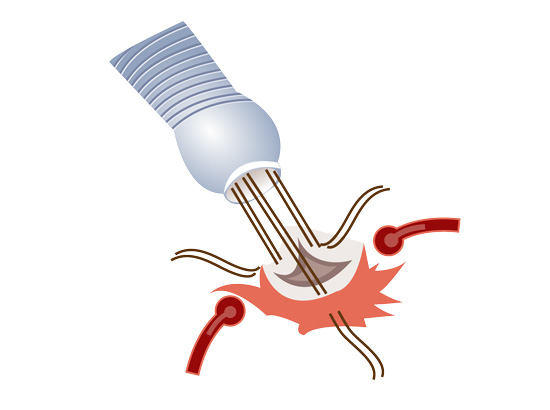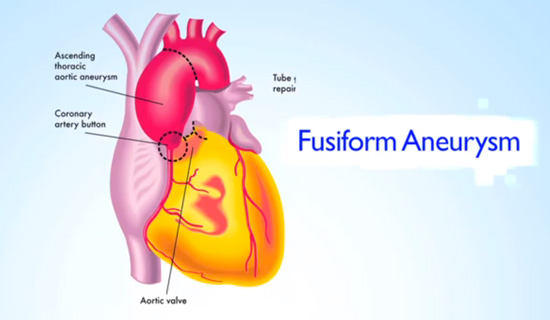“If My Aortic Aneurysm Needs Fixing, Can You Save My Aortic Valve?” asks Ishmael
By Adam Pick on April 9, 2015
Many patients with valvular issues — especially bicuspid aortic valves — also have ascending aortic aneurysms.
At the same time, patients can have isolated aortic aneurysms without any form of valve disease. For example, Ishmael asked me, “Adam, I have a 4.4-cm ascending aortic aneurysm. My doctors have been monitoring me for 9 months. I am going in for a CT scan again soon. My aortic valve is healthy. What is the success rate (or mortality rate) to fix the aneurysm and leave my valve alone during the procedure? I am 60 years old.”

To get Ishmael an expert opinion on this question, I contacted Dr. Eric Roselli from the Cleveland Clinic. So you know, Dr. Roselli is aortic aneurysm and valve specialist having successfully treated many patients in our community including Denise Kirchner, Matt Millen, Helen Holmes and, most recently, Cristen Marzula.

In Dr. Roselli’s response to Ishamel, he first addressed the diagnostic process specific to aortic aneurysm and valve therapy:
Dear Ishmael: Thank you for the question. The decision about when to operate on an ascending aortic aneurysm is based on a calculation that balances the risks of surgical intervention against the risk of having an aortic complication without aortic replacement. Although we ideally wish we could predict the future for each patient based on the morphology, anatomy, family history and biology of their aorta, right now we are limited in our ability to do so. Having said that, the most important predictor of complications related to the presence of an aortic aneurysm is the diameter. At a diameter of 4.4 cm, your risk of having a complication without an operation is exceptionally low — such that we would not recommend elective repair for an aneurysm of that size as the sole indication for surgery.
Then, Dr. Roselli addressed the connection between bicuspid aortic valves and aneurysms:
You mentioned that your aortic valve is healthy. If that means it is functioning well, that is good news. It is important to know that a young person such as yourself with a dilated ascending aorta does not have a bicuspid aortic valve. In the event that you do have a bicuspid aortic valve, we would recommend operating on your associated ascending aortic aneurysm when it reaches either 5 cm or if you are short in stature, when your maximum aortic area to height ratio exceeds 10. If you have a well-functioning tricuspid aortic valve, then the decision to operate on your aneurysm depends on some other factors.

Next, Dr Roselli addressed other potential risk factors for patients and the shape of aneurysms:
Do you have a family history of sudden death at a young age? Do you have a family history of aortic aneurysms in the chest or of aortic dissection? If so, then we also would consider operating on your aorta when it reaches 5 cm or the ratio threshold of 10, as mentioned earlier. Another important consideration is the shape of your aneurysm. Most thoracic ascending aortic aneurysms are fusiform in nature and so the stress on the walls of the aorta is uniformly distributed. As such, the diameter is a good predictor of risk and a good indicator of when to operate. If you have a saccular aneurysm of your aorta related to a penetrating ulcer or some other disease process, then we may operate sooner. If the pattern of aneurysm in your ascending aorta is such that the aortic root is predominantly dilated with a dilated annulus (the portion of your aorta where the valve is seated on the left ventricle) and the shape of the aortic root is distorted, that may also be suggestive of a genetically triggered reason for the aneurysm. Genetically triggered aneurysms are the ones which we tend to be more aggressive about operating on earlier than at the 5-cm or ratio-greater-than-10 threshold. If your aortic valve is diseased and dysfunctional and requires an operation as the main indication for surgery, then I would replace your 4.4-cm aorta at the same time as the valve replacement.
Dr. Roselli then addressed the question about saving the aortic valve if an isolated aortic aneurysm repair is needed:
If at some point during follow-up your aorta enlarges and reaches a threshold when we think it should be operated on, either 5.5 cm or 5 cm, depending on the other criteria mentioned above, then I would do everything I could to save your native aortic valve as long as the tissues appear healthy and worthy of saving. These operations are best performed at centers of excellence that have a high procedure volume.
Lastly, Dr. Roselli provided insights specific to a recent paper published by his team at the Society of Thoracic Surgeons meeting a few weeks ago:
We recently presented a paper at the STS meeting in San Diego describing our experience in patients with ascending aortas of 4.7 cm or greater and a bicuspid valve. About two-thirds of patients underwent surgery right away and the other third were followed with maintenance imaging studies. In the patients who underwent surgery, the risk of death from the operation was 0.25% and the risk of stroke was 0.75%. This series of more than 800 patients included those undergoing emergency surgery for aortic dissection. In a recent analysis of data from the National STS Database, the average risk of death for elective ascending aortic surgery was just under 4%. These operations are incredibly safe. In the patients who were followed with serial imaging, more than 60% of them needed an operation or had an aortic event within a 10 year follow-up period.
Many thanks to Ishmael for his question and a very special thank you to Dr. Eric Roselli for sharing his clinical experiences and research with our community.
Keep on tickin!
Adam
|
Diana Groves says on April 9th, 2015 at 5:36 pm |
|
I have 4.5cm aneurysm and they did not repair it when they did my second aortic valve replacement.Will I have too have another surgery? |
 |
|
Sandra Wallace McDonald says on April 30th, 2018 at 10:50 am |
|
I have a 4.8 root aneurysm I am 4’8″. I have bypass and aortic valve replacement. When does the chart ratio or when do you suggest this be taken care of? |
 |












